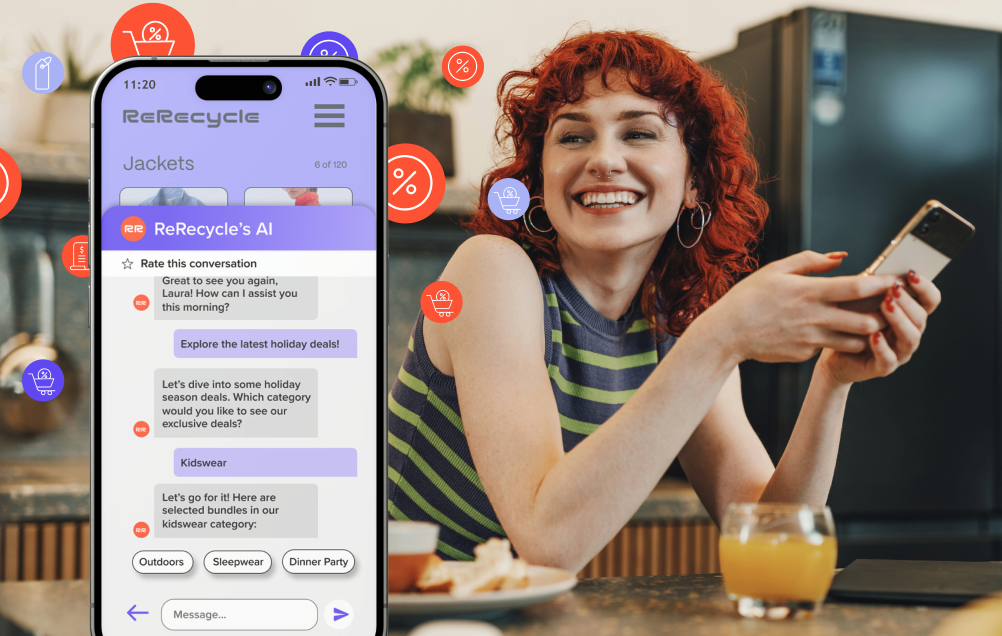REP AI on the DTC Podcast: The eCommerce Funnel is Broken—AI Can Fix It
If you’re wondering whether the emergence of ChatGPT and other generative AI tools are going to impact the eCommerce industry, the answer is a resounding yes. Online retail has been lagging behind its in-person counterpart for years, and the gap is prominent — 2% for eCommerce, 30% for brick-and-mortar.
But the emergence of eCommerce AI tools is already changing that, helping brands across different verticals realize the incremental revenue gains necessary to close the conversion rate gap.
To explain how eCommerce AI tools give you the ultimate sales closers, Yoav Oz and Shauli Mizrahi — CEO and CTO of Rep AI (and cofounders) — sat down with Eric Dyck of the DTC Newsletter and Podcast.
In this episode of the DTC Podcast, Yoav, Shauli, and Eric explore the broken eCommerce sales funnel and how AI chatbots like Rep are poised to transform the industry. Here’s a look at what they get into:
- Does Your eCommerce Store Need an AI Sales Closer? A DTC Podcast Transcript
- How the Modern eCommerce Funnel is Broken
- ChatGPT, First-Mover Advantage, and Conversational Commerce
- Conversational Commerce and Conversational Shopping
- Conversational Shopping and eCommerce Conversion Rates
- Creating an AI Sales Closer for eCommerce with Natural Language Understanding (NLU)
- Improving eCommerce Conversion Rates with Rep’s AI Chatbot
- Which eCommerce Verticals Need an AI Sales Closer like Rep?
- How AI Chatbots Support Your Live eCommerce Sales and Support Teams
- Rep AI’s Training Process and Adapting to eCommerce Brands
- Omnichannel eCommerce Experiences with AI Chatbots
How the Modern eCommerce Funnel is Broken
Eric:
Yoav, Shauli, welcome to the DTC Podcast. Super happy to have you here. Let's start with how you think that the modern eCommerce funnel is broken. How would you say the modern eCommerce funnel is broken?
Yoav:
Oh, wow, I think this is the story that started the company. Basically, I was buying online a lot, a lot. But in the last few years I was seeing a lot of ads, seeing SMS and emails coming to me, and sometimes they were so good that I was jumping in and clicking on them to get to the website. But most of the time, it's a new brand, it's a new product, and I love what I see. But 99% of the time I wasn't buying the product.
So I start asking myself, “Why am I not buying the product?” and I realized that there is no one out there that can answer my questions, like “Are those shoes good for a half-marathon?” or “Is this coffee good with my machine? Is it good with milk?” There is no one out there that can answer my questions that I have in real time.
And it's pretty crazy because, if you think about it, in eCommerce the average conversion rate is like 2% and brick-and-mortar is 30%. But there you have a salesperson that can really answer your questions and guide you to the product that you want, or search for the answer to your questions, and build the trust that you want.
So, we're spending so much money to get customers to our website, you know, and as a brand, in the end, we're not giving them the basics: someone to answer questions about the product in real time.
So this is why I think the eCommerce funnel is kind of broken. It hasn't changed in the past 15 years.
Eric:
And marketers are just spending more and more to get users to their site across all these platforms. They have to continually pay to bring them back again and again, so that's probably one of the biggest opportunities: converting more of those people they're already paying for.
Yoav:
Exactly. So you know, on average, you see 50% of the revenue of these brands being spent on marketing to get people and grow in a linear way. Today, with the recession that's coming and the ads being very expensive, it's not possible to [generate traffic in the ways] it was possible in the years before.
With Rep AI, we're saving this traffic. So, what we're doing is, we give an AI-power guided shopping experience – a solution that can answer product-related questions and mention products to someone that's looking for a specific product.So we know exactly where they’re coming from, what they’re doing on the website, and why they need some help with that.
This is exactly what Rep is: a guided shopping experience. With those four solutions, we pretty much save the traffic that lost [purchase] intent and needs help. We proactively approach them and guide them to the product that they were searching for.
Eric:
I basically had this experience this weekend. I was buying a new (Uh, I live in a duplex and so we need a 24-inch washer-dryer – which are the worst by the way; they don't last), but I went to a site. And this site was organized very poorly,and they had a chat with a rep from a foreign country.This person had no idea about the brand. He was sort of just like, “Oh well, you can use the help here,” pointing me to some very specific things that [actually] didn't really help me.
I went to another site and talked with a more traditional sales rep who could actually say, “Okay, here are the best 24-inch models.” Again, it actually wasn't AI in this case; it probably was a real sales rep. But the difference between those two experiences was night and day. With the first one, I just walked away saying, “Okay, well, you're…not really here to help me at all, right?” And, then, with the second one, we bought a washer dryer — which is huge.
Yoav:
It’s exactly that. If you think about it — sorry, Shauli, for jumping in — like it's okay to have some kind of solution on the website. But if it's not really working, if it's not really smart enough to answer everything, it's not really saving your customers.
Shauli:
I’ll add to what Yoav said.
I think it's really tough to maintain a standard between all your live agents and make sure that all are in top form, and they're all great and all know all the answers to all the questions. First of all, that's a really, really tough thing to have.
Second, they'll never be on 24/7, and they won't approach customers, because you just don't have enough [live agents].
So what they do, they become passive, right? They're waiting for customers to approach them. What brands actually want is less interaction, because they don't want to pay more agents. And what happens is, in the end, they give poor customer experiences because of [that reliance on live agents].
That’s what we're coming to change completely.
ChatGPT, First-Mover Advantage, and Conversational Commerce
Eric:
You know this couldn't happen at a better time. Like, I don't, I don't know how much you knew about ChatGPT…as you're building this company. But, in terms of customer expectations, you go back 10 years ago, and it's like every eCommerce site with a lot of SKUs needs a search bar because people are accustomed to being able to search for things they want.
But now, with the fastest-growing tech platform in history being ChatGPT, more and more customers are going to expect to have that kind of intuitive chat experience. I imagine you guys are leading that charge.
Shauli:
Yeah, exactly. And listen, I think we saw this happening, by the way, a few years ago; there was a big transition from desktop to mobile. The same thing is happening now. The internet will become fully conversational and ChatGPT is basically just the first mover.
By the way, if you don't know what ChatGPT is, I recommend any one of your listeners to read about generative AI or just ask Google. Or even just get ChatGPT and ask it yourself, “What are you?” and you'll get a full explanation. But, it's really revolutionizing the world.
If you go back to what I said about when the transformation was [from desktop] to mobile, brands and merchants that moved to mobile gained the first-mover advantage. The same, exact thing is happening now.
Customer experience for eCommerce will become fully conversational. Customers will be able to have their entire shopping experience through a conversation, and it's not only on websites. It's going to be on any digital platform. So, later on in the future, in the metaverse or wherever it is that eCommerce goes, the conversation is going to be there. Customers want to have a conversation when they shop.
Conversational Commerce and Conversational Shopping
Eric:
It's just super organic. You know, it's funny. I ran an event in 2017 in Berlin, and we had a ManyChat. They had just come out and they gave everyone a live workshop on how to build the chat experience. And at that time, they were talking about conversational commerce. As far as you guys understand, who created or invented conversational commerce and how has it evolved since those early, general messenger chat days?
Shauli:
Right. So I think, if I'm not mistaken, the whole word conversational commerce, the term, was coined around seven to eight years ago. Something like that. Back then what [conversational commerce] meant, or still means today, is basically, “eCommerce that is done through a conversation.” So it could be any type of support or anything like that, not just on the website, but through live chat and different messaging platforms, as you mentioned with ManyChat.
What we're doing [with Rep AI] is actually a bit different. We're focusing on a part of conversational commerce. If conversational commerce is conversation in eCommerce, what we're doing is what we call conversational shopping, which is basically focusing on the aspect of shopping. [Focusing] more on how to increase conversion rate, how to increase the average order value, how to help customers shop. How to help them find the right products, how to help them answer any product-related questions they might have — upselling of course — and just moving them along the funnel all the way from home page to checkout.
Eric:
[Directly] in the chat. Again, that was exactly my experience [with the washer], where I couldn't navigate the site well this weekend. I said, “Just show me the units that fit my criteria.” They sent me the checkout link, and I bought right there.
It was just really like the sales rep experience in a store, right? A traditional chat may have been able to tell you where the washrooms were or some very basic things, but this chat moves you down the funnel in a very specific way, which customers like, generally.
My big question is, “What does this do for conversion rates in [eCommerce] stores, practically?
Conversational Shopping and eCommerce Conversion Rates
Yoav:
I think the best way to answer this is by breaking it down into steps.
So, first of all, you don't want to interfere with people that already came to your site with [purchase] intent, who understand the menu and stuff like that. Let them buy the products that they want to buy. If they get it right, why not?
So, for us, conversational shopping starts with analyzing the people that are about to leave your website. You already spent a lot of the marketing budget to bring them in, but some of them — most of them — at some parts of the sales steps, lose that [purchase] intent. We want to take the [leads and customers] where we know exactly where they came from, what they did on the website, understand why they're…[losing interest], and then approach them proactively. The way that we're doing that is, we're analyzing them, doing behavioral analysis on the website in real time, to know exactly when they're about to leave.
The second thing that we're doing is, we’re proactively approaching [them] and getting the engagement in a very contextual way. Contextual is not only the page that they came into [on your site]. It's where they’re coming from, what they did before, [and] what happened.
And then the third thing that we're doing [with Rep] is guiding them.
So these are the three major steps. Just to summarize them: The first step is, with eighty percent accuracy, we know who is leaving the website and when to approach them before that. Then, on average, 5% of these visitors are engaging with the Rep AI chat. And that 5% engagement means that they are engaging in at least two steps of conversation. Finally, between 10% to 40% of the people that engage with us end up buying a product, depending on the vertical and the brand.
Eric:
That’s quite an improvement, especially on these users that had this exit intent. What percentage of users end up engaging the chat on a session on a website that's powered by Rep AI?
Yoav:
So, if you think about all the chats that exist today for customer support: less than 0.1% [of eCommerce shoppers] are engaging with those chats. No one has built something that's engaging for [online] shopping — to help, to assist, to guide. Those kinds of things.
So that’s 5% engagement from the people who are about to leave. By the way, it's not just exit intent. We don't need them to click on the X button. We know by their behavior, by what they are doing when they're about to leave, that the intent is dropping off. We know to approach them, as I said before, in a very contextual way based on the steps where they are and to approach them [accordingly]. 5% from the traffic that you're about to lose is a lot…a lot, in revenue.
Creating an eCommerce AI Sales Closer with Natural Language Understanding (NLU)
Eric:
Yeah, and I love that you quote it as …a sales closer. I think everyone in this industry is looking for closers. Glengarry Glen Ross said, “Coffee’s for closers,” and now you're training an AI to do this. Like, they can be some of the most expensive parts of a sales team — people that can come in and really close —and you're sort of building this AI system that does it. Does your system get better at closing over time, the more data it has?
Shauli:
Our AI is trained, over hundreds of thousands of sales conversations, to truly understand what customers say when they want help with [eCommerce] shopping.
So, what we do is…connect to the brand’s eCommerce catalog; we pull the purchase history, all the data about their customers, and we also start monitoring the behavior of customers on the website to truly understand when they're facing those problems… And based on that, based on conversations, we know how to optimize it as we go.
For example, if we get failed conversations, conversations that don't go well, we have a team that actually monitors those conversations and tags them with the right intent. So, the system will get better and better the next time when it gets that same kind of conversations. It actually optimizes itself in more of a system view, but also per each brand. So, this optimization happens for each brand.
Eric:
Very cool. Then, is each person's AI siled on their experience? Or does everybody who works with you feed up into making the AI smarter across all brands?
Shauli:
So, both actually. We get on-brand optimization that happens within each [eCommerce user]–questions that we did not know how to answer–and we start answering those. But we also, on the higher level of…basically every brand that works with us, get this sort of mass knowledge that's coming from multiple verticals. We get better and better each time we go by.
So, every brand that comes, every brand that onboards, what they get is actually the latest and best NLU model that [Rep] created, because it gets better and better. By the way, NLU is natural language understanding. So what it does, it knows how to understand when a customer approaches us and starts talking to us or we start talking to them. But the idea is that it analyzes the request and knows what the customer actually wants — to engage in a conversation.
Improving eCommerce Conversion Rates with Rep’s AI Chatbot
Eric:
To give our audience a really concrete understanding of what this process is, Yoav, can you give me an example of a brand — you don't need to tell me the brand— you tell me the category of a brand, and then the experience that they created with Rep AI and how it impacted their sales or their closing rates?
Yoav:
Of course. So today, Shauli, you can correct me if I'm wrong, we are in more than 14 verticals in eCommerce: fashion, CPG, health, beauty – so many brands. So, today we can say for which vertical there are things that are a little bit different from each other.
But I can remember this one [coffee and tea] brand in the beginning, when we started,that had an amazing conversion rate of 7%. A 7% conversion rate [in eCommerce], which was insane.
He told us, “Guys, I'm doing everything — everything — that is possible, and this is why I have a 7% conversion rate.” And we are like, “Okay, if we can increase the conversion rate and show him there’s money left on the table that he’s not getting, we can make it with any brand.”
So, we went live with him, and we increased his conversion rate after the first 30 days by 2%. This was huge. [Just] by approaching the visitors, the customers, that were coming to the website.
And, you know, he had like 100 types of coffee and tea. It was so confusing. The people that love him — the ones that have time to really dive in and check everything [were already buying]. But to have another experience, another funnel that is conversational – besides the menu and the search – that guides you to the product and gives you the options and then – even if you have a problem – can tell you why what's happening and how you can solve it…was huge.
By the way, this brand also increased its subscription by 20% in the first 60 days. So people [were] buying again and again the same coffee. It was so insane to see that.
Eric:
It is; and it's incremental. It doesn't affect your conversion rate in any way for the business that's already converting. Maybe if they engage with it they'll get a better customer experience and [brands] will be more memorable. But I also love this because it's sort of “found” revenue — you're converting people that weren't gonna, maybe convert in other ways, specifically.
Everyone’s looking for incremental gains, and this seems like a pretty smart way to do it.
Shauli:
Yeah, exactly. Just to say one one thing: we approach only the customers that are about to leave the website. We don't approach the customers, as you have mentioned, that are going to buy. So, we give 95% confidence; we know if this is their last page on the website. Only then do we approach and, of course, approach with the right context.
Which eCommerce Verticals Need an AI Sales Closer like Rep?
Eric:
So, what kind of brands should be looking at a tool like Rep? Does it matter? Do you need brands that have … multiple SKUs or sort of complex sizing or buying cycles?...What's the complexity of a brand that's going to benefit most from Rep?
Yoav:
So, first of all, we want to bring Rep AI to any and every digital platform, for any brands on any eCommerce platform. Even the ones that have built everything in-house. But because we're a young company that we launched last year today, we [currently] only support Shopify merchants, brands of any size.
By the way, it's a one-click integration that takes 3 days for the AI to train, [provided] you have more than 25,000 monthly visitors. This is the only restriction now — not SKUs, nothing like that. You can have like 2-3, and you can have 1,000. We don't have any restriction for that, but you do need to be on Shopify and have more than 25,000 monthly sessions.
In the future we want to bring Rep to any brand of any size on any vertical and, of course, on any eCommerce platform.
Shauli:
Just wanted to add to what Yoav said:
So, basically, any brand that suffers from a conversion rate problem, or wants to increase the average order value, or wants to increase their…number of subscriptions to email and a SMS — any brands that they have that problem, and they want to actually get better, okay, they can come to us, and we're going to make it better.
The way we do that is because, one, we don't approach any customers that are…going to buy, so when we approach, we only approach customers who are going to leave.
The second is the fact that we help them. We help them with whatever they need to make sure we close the sale.
So, if [the customer] needs help to understand which product is for them, we'll have someone doing that. If they need help understanding if the product that they're interested in is the right product for them, because they have a few doubts, we’ll help them sort out those doubts and make sure we push them to buy that product. If they have last-minute doubts about shipping fees or anything like that, we'll also try to relieve those doubts and push them to check out.
The whole idea is that we increment the amount of revenue that's on the website.
Yoav:
And if I can add one more thing: we really fit great for brands that already have a chat.
By the way, I like human chats, because customers already know that [the brand] has a chat that provides support. They know they can talk to someone. And we are complementary to any live human chat.
If you’re a brand that's working with Gorgias or Zendesk, we’re complimentary to [those tools]. So, anyone that now approaches the chat, or the chat approaches them, can get a fully-automated sales [experience]. At any point in the funnel, if the AI doesn’t understand you, or you want support, you can click “Live Human” and can talk to someone.
So, [Rep] is empowering the chat that you already have today.
How eCommerce AI Supports Live Sales and Support Teams
Eric:
It's super interesting.
I haven't actually seen it on a site personally. When it's on a site, do people know they're interacting with AI? Does it pass the Turing test? That's my, that's my geek question.
Shauli:
I think…it all depends on what brands want. They can, they can choose to basically name it “My Brand's AI” or they can name it “Sarah.” So it really depends on where they want to take it.
The whole idea, which you have mentioned, is that if the AI does not answer — and that happens, unfortunately –, what can you do? Then the AI knows to transfer the conversation to a human agent working with Gorgias or Zendesk, one of those platforms, in a very seamless way.
So, in the same chat box, [Rep AI] says, “Sorry I couldn't help you with that; I'm going to transfer you to my human supervisor to continue the conversation.” Then [the customer] is transferred to the human agent who can continue the conversation from the same point on.
Yoav:
And also, behind every smart AI, you have a smart human. So basically, when the human support is answering the questions, the AI learns the answer from the human behind it and then knows how to answer [that same question] in the future.
Eric:
I love it.
And it's like, the more people experience AI and chat AI — which is, you know, growing by a million more every week now — the more an AI experience on an [eCommerce] website will be a benefit in a way, right? It'll be something novel. It'll be something that they're used to, like interacting with ChatGPT.
Like you say, there's that first-mover advantage, potentially, for [brands] jumping into this.
Yoav:
Exactly, exactly.
Rep AI’s Training Process and Adapting to eCommerce Brands
Eric:
I want to ask: when you get started on Rep AI, what does the AI training process look like? How intensive is it on the brand side for getting this up and running?
Shauli:
So basically, our NLU model is already trained on many, many different verticals; on many, many different [eCommerce] websites; and on conversations and session history. So what you get, as a new brand that onboards, is basically the…the freshest and best AI model.
When we do connect [Rep AI] to your eCommerce catalog, we pull all the information about your products, all the information about your customers, and we start monitoring the behavior of customers on the website to make sure that we really understand the problems that your customers are facing. [We do this] to make sure that we're able to have a full-sense conversation about your products with your customers. So, that happens automatically.
And it only gets better with time. Because what happens is we get new conversations coming in, new requests that we don't know how to answer, and then our team tags them to make sure that next time, when we face those questions again, we'll be able to answer them [correctly].
Omnichannel eCommerce Experiences with AI Chatbots
Eric:
Nice. Okay, so I have ChatGPT; I have messaging experiences across all these other messaging platforms — what's the future for how Rep will work seamlessly in other messaging environments?
Yoav:
This is exactly our plan for this year.
So, we believe that the future of eCommerce is going to be conversational and data-driven. Like, 5, 7 years from now, we believe that most of eCommerce is going to be fully conversational: you can talk to the store, text them, even use your voice, with any messaging platform, not only through the website.
This is exactly what we're doing this year. We’ve already started integrating with Facebook Messenger, WhatsApp, and more messaging platforms. So basically, you can still build your website on Shopify, [continue to] do everything that's happening over there and manage it, but also connect to the store on any messaging platform in the future — any digital platform.
We are a data company. We're training the AI to be the best salesperson, clerk, or concierge…we’re giving the best, the best, experience for your customers — not only on the web, but also Messenger, WhatsApp, and the rest of them.
Eric:
As a marketer, I remember back when chat funnels — I think people are still running…chat marketing as well, like from an ad into a chat experience. But marketers are always also talking about an ad-to-survey experience, or a quiz, or something like that. And I can imagine an AI-powered ad experience soon too, where you can really engage and hook people, with AI, in an ad messenger environment as well.
I’d be interested to see how that works.
Shauli:
Yeah, that's exactly our plan for the next year — to get people from a Messenger ad all the way to a conversation in the platform and, if needed, move them to the website or close the sale inside of Messenger. Or get them onto the website and continue the same conversation.
So your conversation is seamless; it starts from the messenger ad and goes all the way to checkout within the same conversation, the same context.
Eric:
Very interesting. Is there a world where AI back ends will connect? Where you'll be able to plug into ChatGPT for any reason? Is there a reason where AI will become more connected on the back end?
Shauli:
So, the way we see that is, yes, if you have ChatGPT as the main and the smartest being that's out there, you can ask it to enhance our AI going forward. This is something that we're considering doing. We're trying to work with openAI to see how we can work on that and have an integration to actually enhance our solution.
Eric:
You don't want to take it too far away from the purchase experience, but if I wanted to have the AI write a poem for me in a Wordsworth style, or a Tupac rap about a product, you'd need ChatGTP to jump in there.
But again, you don't want to take them too far out of the purchase experience, which is what you might do if you had a wide ranging plug-in like ChatGPT or Bing. Whatever Microsoft's doing with Bing is going to be big as well.
Shauli:
It's true. The way we see it, and the way we started the company, is we try to mimic the behavior of a sales associate in a brick-and-mortar store. Try to go to a sales associate in a brick-and-mortar store and say, “Hey, can you write a poem for me?” She or he would say, you know, “Go. Go. Get out. This is not where you write poems.”
Basically, we train our AI to be focused on help with shopping. How do I increase conversion rate? How do I help customers shop?
Eric:
Nice, yeah. It makes me think of Zappos. The story of Zappos customer service back in the day was epic. You could go and ask them, “Where's a local pizza place?” or whatever, and they would just go above and beyond. So it's going to be interesting to see the way this system evolves to give people delightful experiences. Because I think that it comes down to just like creating novel, delightful experiences for customers and it seems like [Rep AI] has that potential for sure.
Yoav:
Exactly. This is what we're aiming to do. Conversational shopping is something new, and our solution of guided shopping experiences is part of it. We are building, pretty much, the solution that we believe any [eCommerce] brand needs now and will need in the future.
No More Excuses — Repair Your eCommerce Funnel with Rep AI
Artificial intelligence is poised to be the great equalizer — bringing eCommerce conversion rates closer to the level of brick-and-mortar stores. All you need to do is take that first step.
Rep AI is already empowering brands across verticals like fashion, CPG, and even luxury furniture, providing a digital sales closer that helps rescue revenue while leaving live sales agents to do their thing.
Use the AI Simulator for a sales-free demo of REP's capabilities.
Or check out our ROI calculator now and see just how much money you can save with Rep’s AI concierge.

.png)










